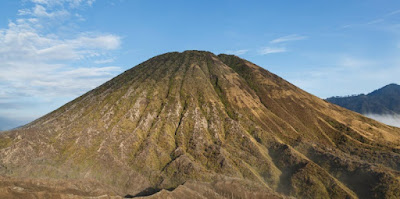One of the most notable volcanic peaks in Indonesia's East Java is Mount Batok, which is part of the Bromo Tengger Semeru National Park. At about 2,440 meters (8,005 feet) in elevation, it is frequently eclipsed by Mount Bromo, its more well-known neighbor. But Mount Batok has its own special charm, defined by its craggy, textured slopes and remarkably symmetrical cone shape. With no known eruptions in recent memory, Mount Batok is regarded as dormant, in contrast to Mount Bromo, which is still an active volcano. Particularly when seen from a distance, the mountain's slopes are covered in a mixture of grass, tiny plants, and volcanic ash, giving it a characteristic brown and green appearance. Mount Batok's placement amid the "Sea of Sand," an enormous area of volcanic sand that envelops both Mount Batok and Mount Bromo, is among its most alluring features. Due to its eerie scenery and remarkable structure, the mountain is a favorite photo subject and a must-see location for those touring the Bromo Tengger Semeru National Park. Visitors will have an amazing time at Mount Batok because of the area's magical aura and stunning natural surroundings. Source



%20Panoramic%20View%20of%20Mount%20Batok,%20Mount%20Bromo%20and%20Mount%20Semeru.jpg)




.jpg)
.jpg)
.jpg)
.jpg)
.jpg)
.jpg)
.jpg)
.jpg)
.jpg)
.jpg)
.jpg)
.jpg)
.jpg)
.jpg)
.jpg)
.jpg)
.jpg)
.jpg)
.jpg)
.jpg)
.jpg)
.jpg)
.jpg)
.jpg)
.jpg)
.jpg)
.jpg)
.jpg)
.jpg)
.jpg)
.jpg)
.jpg)
.jpg)
.jpg)
.jpg)
.jpg)
.jpg)
.jpg)
.jpg)
.jpg)
.jpg)
.jpg)
.jpg)
.jpg)
.jpg)
.jpg)
.jpg)
.jpg)
.jpg)
.jpg)
.jpg)
.jpg)
.jpg)
.jpg)
.jpg)
.jpg)
.jpg)
.jpg)
.jpg)